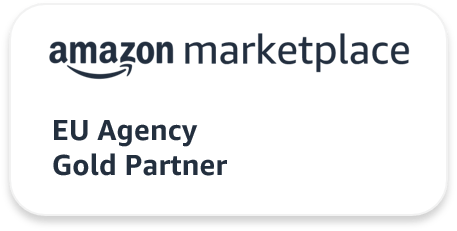How to rank on the first page of Amazon
Are your Amazon sales not improving no matter which trick in the book you apply? Are your product listings not popping up on the first page of Amazon?
Amazon sales are tied to your product listings being visible and vice versa. But before we can talk about how to make those listings show up on Amazon’s first page of search results, we should quickly discuss how to increase sales on Amazon.
How to increase sales on Amazon: Top tried-and-tested methods
Once people find you on Amazon’s first page, that’s only half your work done. Both Amazon first-page rankings and increasing sales are interlinked – so you need to work on both, sort of have a “give and take” thing going on.
Method #1 – Increase external traffic
Most likely the best way to increase Amazon sales now is to run off-Amazon promotions. Also called external traffic, off-Amazon traffic channels help you find a new audience – people who aren’t looking for your products on Amazon but can greatly benefit from them regardless.
Utilise commonly used external traffic channels like Google, Pinterest, Facebook, Instagram, TikTok, Email marketing, social media influencers, blogs, and so on.
Now, to drive product sales via these external traffic channels, you must offer an exclusive to your potential customers – like a single-use promotional code, for example. Money-off discounts have stood the test of time and always entice people to buy things, sometimes, things they may not even need! Running promotions this way will result in a sales spike, with the resulting momentum carrying over to your organic, full-priced sales. Genius!
TikTok, Google and Facebook, for example, are an untapped source of traffic for Amazon sellers, so start taking advantage of these now.
Method #2 – Start retargeting
In the process of unveiling your offering to a completely new audience, chances are not everyone is going to want to buy it right away – even if you offer them a nice chunky discount code.
Therefore, what true marketing legends do is that they retarget audience members who have already shown a little bit of interest in their brand, which is, of course, done step by step so that those audience members have more than a few reasons to buy.
It’s always a great strategy to retarget those who have expressed interest in your brand – perhaps they clicked on an ad of yours or interacted with you on social media in some way or the other. When you send follow-up marketing campaigns their way, you’re essentially generating a high ROI which delivers far better results as opposed to retargeting completely new audience members.
Already running external traffic marketing campaigns? Great! Simply start running follow-up campaigns to those who have interacted with any of your initial marketing content. So, send people through a shortened URL or a landing page, for instance, where you can embed a pixel. This will easily let you track those who interacted with your first ad, thus, allowing you to direct your marketing campaign specifically toward them.
Method #3 – Promotions on Amazon
On-Amazon promotions, especially when combined with external traffic promotions, is a very simple and direct way of increasing Amazon sales. You can choose from different types of promotions to run, such as 7-Day Deals, Lightning Deals, and Amazon Coupons.
The majority of deals you set up via Amazon will appear on Amazon’s showcase pages, search results page, and your own product listing. This way, you will have better visibility and see more sales conversions from people who do find your product.
It’s worth noting, however, that showcase deals like Lighting Deals can cost a bit of money to run as they are quite competitive – most Amazon sellers are already utilising them. At the same time, if you’re willing to put down the initial investment, you’ll find that this is an excellent way to boost sales velocity and create some much needed momentum for your product to start ranking higher.
Consider adding coupons to your current listings or running a Lightning Deal to boost sales. The momentum you gain from your promotion will more often than not lead to higher organic rankings and sales once the deal is over.
Method #4 – Optimise product listing for sales
Unfortunately, even to this day, we often come across poorly written Amazon listings, which are written primarily for the sake of using keywords, and not written organically for a real person! Among these, you’ll find lacklustre copywriting with basic grammatical mistakes, a lack of flow from sentence to sentence and just not very professional looking descriptions – anyone reading these listings is not going to be impressed, let alone feel compelled to buy anything at all.
Let’s run a quick checklist then to ensure you aren’t making these mistakes:
- Check to make sure the sentences make sense, flowing smoothly from point to point
- Ensure there are not grammatical mistakes
- Ensure that there are no spelling mistakes, and that you are using the correct spellings based on your target audience (American vs. British, for example)
Big walls of text don’t work too well either, so try to make your description as concise as possible – if you can get each point across in 10-12 word sentences then there’s no need to write an entire 50-word paragraph for each selling point or feature! Shoppers want to be able to quickly scan the text and see the value proposition or benefit with little effort.
Keywords are important too, so let’s not forget those! Just use them cleverly throughout the text and in a natural and organic way.
Aside from the above four methods, there are a handful of other ways to boost sales on Amazon, which Chris and his team would love to discuss with you. For now, we need to s shift our attention to more pressing matters:
How to boost Amazon ranking – 5 things you can try now with fantastic results
1. Research competitors and analyse their product listings
Competitor analysis should ideally be done even before launching your listings, but if you already have, it’s okay, we can still do what we must in order to boost our Amazon ranking.
Collecting as much information as possible on your competitors, including what works for them and what doesn’t, is an important process to help boost your own ranking. While there are tools available online to help you understand what kind of keywords your competitors are using, what their customers are saying on social media, or what kind of marketing strategies they are employing, for example – nothing beats the honest, upfront and real-time advice you get from an Amazon marketing agency with decades of experience.
2. The right keywords in the right places
Amazon’s A10 algorithm analyses a vast amount of data and considers a variety of factors including the keywords you use in your product descriptions, product titles and bullets, as well as your backend keywords.
Rigorous keyword research needs to be done to find out which keywords you should be using in your listing. Also, take into account the keywords you have gathered via competitive research. Finally, integrate each keyword strategically, subtly and naturally to avoid grammatical errors, redundancy and overstuffing.
3. NO keywords stuffing (seriously, don’t do it!)
Given all the high-ranking keywords you’ve researched, it can be very tempting to include all of them and use them as frequently as possible in your listings, even if they don’t make sense in an organic way. A lot of sellers do this in the hopes of ranking higher on Amazon – but find out the hard way that it can have the opposite effect.
Stuffing keywords may ‘expose’ your products for a short while, and you may even enjoy the limelight for a brief moment on Amazon’s first page, but the dreaded A10 algorithm is really good at detecting keywords stuffing.
As soon as Amazon discovers keywords stuffing, it will downgrade your listing, putting your rank much lower than your competitors. Why harm your overall ranking and sales? Consult an expert Amazon marketing agency to understand the subtle art of keywords to rank high on Amazon.
4. High-quality photos and videos
Apart from keywords, the A10 algorithm also analysis the photos and videos you upload on your listing. Amazon recommends following its file size and background colour guidelines when uploading product photos and videos so that your ranking does not get adversely affected.
Make sure your product photos and videos are as high quality as possible, while also complying with Amazon’s background colour and file size guidelines. If you’ve qualified for A+ content, then that’s great – you can leverage that to add enticing product videos. More importantly though, working with a professional Amazon ranking agency to take photos and shoot videos will ensure that you have powerful materials at your disposal to attract the most amount of buyers.
5. Competitive pricing
How are your competitors pricing their products? Are you pricing your products higher than theirs? If so, does your product offer certain benefits such as free shipping or discounts on volume purchases, for instance?
Setting your prices competitively is very, very important on Amazon as overpriced products tend not to rank very high, unless there is an already established consumer base and demand for them.
There are nearly a dozen or more ways you can leverage to rank higher on Amazon search results pages, including improving your shipping process and signing up for Amazon FBA – although Chris and his amazon agency team would be delighted to review your listings and discuss the methods which strategically offer the most ROI.




